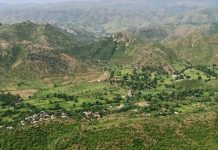
The forest department, along with the Chhattisgarh biodiversity board, has chalked out a comprehensive strategy to protect dinosaur-era tree ferns in Dantewada, writes Deepanwita Gita Niyogi
The Bailadila mountain range in Dantewada district of Chhattisgarh, which has the Bacheli and the Kirandul iron ore mine complexes of the National Mineral Development Corporation, is densely forested. In this region, the rare tree fern having a single erect trunk and belonging to the genus Alsophila is found.
Towards the end of last year, the forest department undertook a survey to count the number of tree ferns, along with the help of volunteers and state biodiversity board members. A set of recommendations has been prepared for 1,347 tree ferns found along the Gali nullah, a perennial rivulet. The area lies between iron ore deposit five and deposit 11 belonging to the mining giant.
The particular area in Bacheli where tree ferns are found gives the impression of a tropical rainforest where sunlight finds it hard to reach the ground. Experts and activists fear that with the continuance of mining pressure, the region’s climate may alter, temperatures rise and tree ferns cease to exist as they need a moist condition to thrive.
Forest beat guards CR Sori and Prince Darro, who showed around the area, informed that counting of tree ferns was carried out over a decade ago as well. In 2008, a forest department survey had found 459 tree ferns in an area measuring 35 hectares.
Conserving tree ferns
Dantewada divisional forest officer Sundeep Balaga said a thorough exploration was carried out during which local youths visited the spot. The vegetation pattern around the nullah is unique. The entire Bacheli range is also a hotspot for bear, hyena, chital, wild boar and leopard.
“The survey was on for five days during which the height of the existing tree ferns measured ranging from three to seven feet. At present, a fenced boundary wall exists with a board declaring the presence of tree ferns. It is the only motorable road leading up to the spot. However, there are tree ferns along the entire nullah stretch both upstream and downstream, for a distance of up to 12 km,” Balaga added.
With the intensification of mining operations in the area, forest is being cleared. Thus, it is of great concern. At present, six mine deposits are operational in Bacheli and Kirandul towns. The company has in total nine leases in its favour.
Tree ferns, also known as pteridophytes, are called living fossils and have a lengthy record of dating back to the Jurassic and Triassic periods. Retired professor of life sciences from Pt. Ravishankar Shukla University in Raipur ML Naik said he has come across tree ferns in Korba district and the Tulsi Dongri patch in Bastar. Tree ferns are also found in Panchmarhi, Madhya Pradesh.
Jai Narayan, who runs non-profit Vanya, based in Dantewada, said it is a good sign that volunteers with degrees in life sciences, botany and forestry were taken there by forest officials. But public awareness is needed. According to him, the area should be left intact. “It is of concern that day by day soil moisture is decreasing and ferns need a moist ground to stay alive. It may be of help if the area is more densely forested,” he added.
Coming to the rescue
Dantewada resident Deepak Singh Thakur accompanied forest department officials as a volunteer during the survey held in October. Thakur helped the department by clicking photos of tree ferns and carrying out measurements.
Another volunteer, Manoj Kashyap, said a set trail already existed along which proper documentation of tree ferns took place. “Officials told us how to work as it is a sensitive area which cannot be visited every day. To protect the area, all activities should be banned in the vicinity of tree ferns.”
Things look hopeful. A set of guidelines has been given to the forest department on how to conserve tree ferns in future. Their growth rate is extremely slow. In about 500 years, these ferns attain a height 8-10 feet. They also evolve over the years; while some ferns grow others do not.
The conservation plan for tree ferns includes protection of the entire catchment area of the nullah and monitoring its water quality at an interval of six months. This is important as water quality would have a direct impact on the roots of tree ferns.
The Gali nullah’s flow slows down in summer and winter, but during monsoon it is full of water. Member secretary of Chhattisgarh biodiversity board Arun Kumar Pandey pointed out that water is the main factor in Bacheli, along with the climate, due to which tree ferns thrive here.
As a protection measure, water conservation work would be carried out to ensure adequate flow during lean seasons. “Fund has been set aside for this. A plan made earlier somehow failed to take off but now the biodiversity board would start work soon,” Pandey said.
The total proposed expenditure would be worth Rs 322 lakh. Conservation measures include entry and exit gates for traversing, nature trail for research and study, conferring of biodiversity heritage status to tree ferns and a proposed lab for conservation of the germplasm of tree ferns.
On his part, Naik said though the forest department and the biodiversity board intend to conserve tree ferns, he is not sure how far they would succeed. He fears mining disturbance may impact their survival which depends on the local micro climate of the nullah. The rivulet is under pollution threat caused by mining waste. The forest area around the rivulet also faces pressure from local hunters.
Community pressure also cannot be ruled out. People living in and around Bacheli enter forests for collection of minor forest produce and firewood. According to Rajesh Karma, the beat guard of Bacheli range, people cross the tree fern area to visit the weekly market. Even though the gate is there, it is kept open as rangers and department officials make visits for monitoring. The gate and the fence were set up around 2016-17.
“Villagers also take part in the annual hunting expedition locally called ‘parad’, held from March to June every year. For the past four-five years we have been telling them that tree fern is a rare species. But though some understand, most people do not. We are trying our best to ensure that they give up hunting,” said Narayan.
Along with Vanya, the department is also trying to spread awareness at the local level. In future, some people may be engaged to act as tourist guides to visitors. “On our part, we urge locals not to cut down or harm the tree ferns in any way. They have been told to inform us in case they come across more tree ferns in the area,” Karma said.













